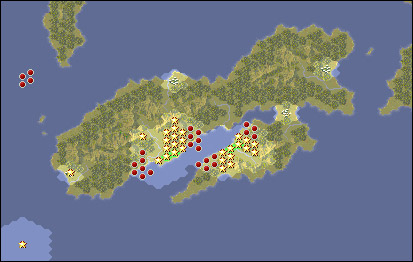 When you move the mouse pointer over the map, unit name, strength and coordinates are displayed as a label. When you press terrain button object name is displayed (city, river, sea, ...) |
Amboina
31.1.1942 - 7.2.1942
PacPG: 31.1.1942 - 7.2.1942
Scenario Map:
|
|
|
Changes and corrections of map:
|
Scenario author: Scenario origin: Last revision date: |
Hartmann 25.9.2006 25.9.2006 |
First release: Revision released: |
- - |
| Completely new scenario. The Japanese conquest of the Dutch island of Amboina. |
Historic overview:
The task of performing the landing at Amboina was entrusted to the proven Rear Admiral Tanaka and his 2nd destroyer squadron and 11 transport ships. At dawn on January 31st the Japanese opened the landings, supported by seaplanes from CHITOSE and MIZUHO anchored in Manado (Celebes). The garrison put up a stiff resistance but surrendered on February 3rd. Fighting in the area, however, lasted until the February 7th. The only outside help was the sending of the submarine SHARK, which fired three torpedoes at the transport ships anchored in front of Ambon on February 1st, without achieving success. (Jaroslav Hrbek - Krvavé oceány, Naše vojsko 1994) Article on English Wikipedia
| ||||||||||||
Game play matters:
| Campaign play: The first scenario of Dutch mini campaign. Any result leads to the Timor scenario. |
Scenario data:
|
Map size: 52 x 32 hexes 8 turns, 1 day per turn Version: PacAGPG 1, Starting side: Allies, Campaign: Dutch minicampaign, Order in campaign: 1. |
||||||||
|
||||||||
|
||||||||
|
||||||||
|
||||||||
|
Game time costingness of scenario: 3.38 % (product of units and turns numbers divided by difference between the most long and the most short scenario) |
||||||||
|
Number of Allied units: 28 units, from them are 12 core units and 16 auxiliary units 0 air units, 1 naval units and 27 ground units 0 of units are loaded to air transport and 0 to naval transport |
Transports Air/Naval: Allies - Axis 0/0 - 0/10 |
|||||||
|
Number of Axis units: 30 units 4 air units, 6 naval units and 20 ground units 0 of units are loaded to air transport and 6 to naval transport |
Initial prestige + every turn donation: Allies / Axis 360 + 30 / 0 + 0 |
|||||||
|
Max number of Allied units: 30 units, from them are 13 core units and 17 auxiliary units - on start of scenario is possible to purchase 2 unit (1 core + 1 auxiliary) |
||||||||
|
Max number of Axis units: 30 units - on start of scenario is possible to purchase 0 unit |
||||||||
Transport units:
|
||||||||
|
| Allied units: Infantry 41 (USA) Submarine (USA) Dutch Infantry (Dutch) 37mm ATG (Dutch) AF 75 mm Gun (Dutch) 3´´ Coastal Battery (Dutch) AF Truck (Dutch) ANZAC 1940 (Australia & New Zealand) HW Infantry 36 (Australia & New Zealand) 15 Pdr Gun (Australia & New Zealand) 40mm Boffors (Australia & New Zealand) 20mm AD (Australia & New Zealand) GB 3 Ton Lorry (Australia & New Zealand) |
Axis units: Kyoka Hohei 1940 (Infantry HW 1940) (Japan) Hohei 1940 (Infantry 1940) (Japan) Type 95 Ha-Go (Japan) Type 94 37mm (Japan) Type 94 75mm (Japan) Meiji 38 Improved 75mm Field Gun (Japan) A6M2 Zero (Reisen) (Japan) D3A Val (Japan) B5N Kate (Japan) Destroyer (Japan) Heavy Aircraft Carrier (Japan) Isuzu Type 94 6-Wheeled Truck (Japan) Transport (Japan) |
The same time period scenarios:
| Singapore (PacAGPG 2), Singapore (PacPG 1), Dutch East Indies (PacPG 1) |
| Ambon Ambon Airfield Ambon Bay Baguala Bay Banda Sea Batu Gajafi River Cape Lia Cape Sial Ela Island Haruku Straits Display all mapnames in list... |
Tactical map (large & detail):

|
|
|
|
Basic map |
|
|
Map with unloaded transports and order numbers of units |
Battlefield map:


|
|